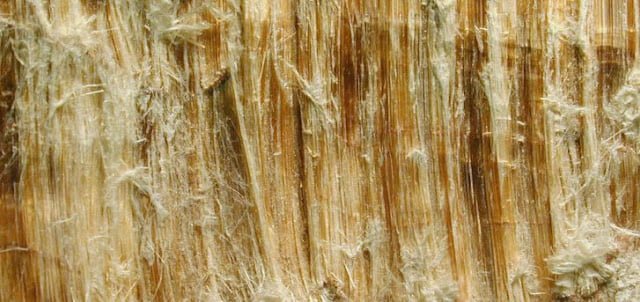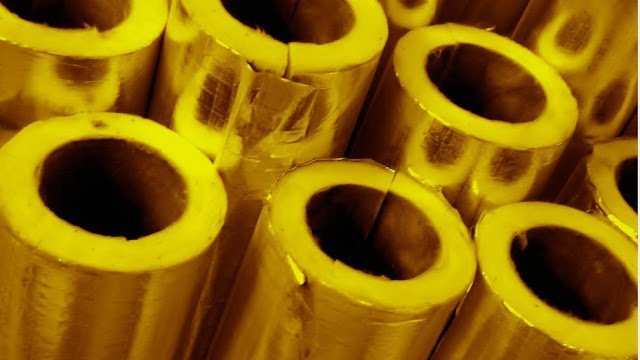An Overview of Asbestos Fibre
Last updated on September 30th, 2023 at 11:23 pm
Introduction
Asbestos is known to heavy toxicity. The inhalation of this toxic fibre can cause serious illness, including malignant mesothelioma, asbestosis, and lung cancer (also called pneumoconiosis). Since the mid 1980s, many uses of this fibre have been banned in several countries.

This fibre became increasingly popular among manufacturers and builders in the late 19th century due to its resistance to electricity, heat and chemical damage, its sound absorption and tensile strength. When it is used for its resistance to its heat or fire, the fibres are often mixed with cement, woven into fabric or mats. It was used in few products for its heat resistance, and in the past was used on electric oven and hot plate wiring for its electrical insulation at elevated temperature, and in buildings for its flame retardant and insulating properties, flexibility, tensile strength and resistance to chemicals.
Definition of Asbestos
Asbestos is a naturally occurring silicate mineral with long, thin fibrous crystals. The word asbestos is derived from a Greek adjective meaning inextinguishable. The Greeks termed it as the miracle mineral because of its pliant and soft properties, as well as its ability to withstand heat.
Types of Asbestos
Six minerals are defined as ‘asbestos’ including:
- Chrysotile
- Crocidilite
- Amosite
- Anthophyllite
- Actinolite.
Uses of Asbestos
Serpentine Group
Serpentine minerals have a layered or sheet structure. Chrysotile is the only of this mineral in the serpentine group. In the United States, chrysotile has been the most commonly type. According to U.S. EPA Asbestos building Inspectors Manual, chrysotile accounts for approximately 95% of it often present in a wide range of materials, including:
- Joint compound
- Mud and texture coats
- Vinyl floor tiles, sheeting, adhesives
- Roofing tars, felts, siding, and shingles
- “Transite” panels, siding, countertops, and pipes
- Fireproofing
- Caulk
- Gasket
- Brake pads and shoes
- Clutch plates
- Stage curtains
- Fire blankets
- Interior fire doors
- Fireproof clothing for firefighters
- Thermal pipe insulation

In the Australia and European Union it has recently been restricted as a potential health hazard and is not used at all. Japan is moving in the same direction, but more slowly.
Amphibole Group
In the amphibole group five types of asbestos are found: amosite, crocidolite, anthophyllite, actinolite and tremolite. Amosite, the second most likely type to be found in buildings, according to the U.S. EPA Asbestos Building Inspectors Guide, is the “brown” asbestos.
Crocidolite and amosite were formerly used in many products until the early 1980’s. The use of all types of asbestos in the amphibole group was banned in much of the Western world by the mid 1980’s, and by Japan in 1995. These products were mainly –
Ceiling Tiles and Low Density Insulation Board
Asbestos cement sheets and pipes for construction, casing for water and electrical/telecommunication services.
Thermal and chemical insulation (i.e. fire rated doors, limpet spray, lagging and gaskets)
Health Effects of Asbestos
Chrysotile asbestos, like all other forms of industrial fibres, has produced tumors in animals. Mesotheliomas have been observed in people who were occupationally exposed to chrysotile, family members of the occupationally to make known, and residents who lived close to asbestos factories and mines. Amosite is the most hazardous of the asbestos minerals due to its hollow straight fibre structure that can stay airborne for up to 72 hours. It also does not get trapped by water as easily as the serpentine fibres do of crysotile. Tremolite often contaminates chrysotile, thus creating an extra hazard.
Its exposure becomes a health concern when high concentrations of these fibres are inhaled over a long time period. People who became ill from this fibre are almost always those who are exposed on a day-to-day basis in a job where they work directly with the material. As a person’s exposure to fibres increases, either by breathing more fibres or by breathing fibres for a longer time, that person’s risk of disease also increases. Disease is very unlikely to result from a single, high-level exposure or from a short period of exposure to lower levels.
Construction
In the developed countries
The use of this fibre in new construction projects has been restricted for health and safety reasons in many developed countries, including the European Union, Japan, Australia, and New Zealand. A notable exception is the United States, where asbestos continues to be used in construction such as cement asbestos pipes. Until the mid-1980s, white asbestos was used in the manufacture of Artex a decorative stipple finish. Prior to the ban, asbestos was widely used in the construction industry. Many older buildings contain asbestos.
In the developing countries
Some developing countries, such as Bangladesh, China and India, have continued widespread use of asbestos. The most common is corrugated cement sheet or “A/C Sheet” for roofing and for side walls. Millions of homes, schools, factories or sheds and shelters continue to use this fibre. Cutting these sheets to size and drilling holes to receive “J” bolts to help secure the sheets to roof framing is done on site. There has been no significant change in production and use of “A/C” sheets in developing countries following the highly restrictions in developed nations.
Disposal and Recycling
In most developed countries, this fibre is typically disposed of as hazardous waste in landfill sites. Asbestos can also be recycled by transforming it into harmless silicate glass. A process of thermal decomposition at 1000-12500C produces as a mixture of non-hazardous silicate phases, and at temperatures above 12500C it produces silicate glass. Microwave thermal treatment can be used in an industrial manufacturing process to transform asbestos and containing waste into porcelain stoneware tiles, porous single-fired wall tiles, and ceramic bricks.
You may also like: An Overview of Glass Fiber Fabric




Very informative article.Is this fibre really prohibited to use?
Those guidelines additionally worked to become a good way to recognize that other people online have the identical fervor like mine to grasp great deal more around this condition.
A lot of of whatever you say happens to be supprisingly legitimate and it makes me ponder why I hadn’t looked at this with this light before. Your article truly did switch the light on for me personally as far as this specific subject goes. Nevertheless at this time there is actually one factor I am not necessarily too comfy with and whilst I attempt to reconcile that with the main theme of your issue, allow me observe what the rest of the readers have to say.Well done.
A powerful share, I simply given this onto a colleague who was doing a little bit evaluation on this. And he actually bought me breakfast as a result of I discovered it for him.. smile. So let me reword that: Thnx for the deal with! But yeah Thnkx for spending the time to discuss this, I feel strongly about it and love reading extra on this topic. If doable, as you become experience, would you thoughts updating your blog with more particulars? It is extremely useful for me. Massive thumb up for this blog put up!
Thanks for your help and for writing this post. It’s been great.
Thank you for sharing this article with me. It helped me a lot and I love it.
Thank you for writing this article. I appreciate the subject too.
Thanks for your help and for writing this post. It’s been great.
Thanks for posting. I really enjoyed reading it, especially because it addressed my problem. It helped me a lot and I hope it will help others too.
Great content! Super high-quality! Keep it up!
May I have information on the topic of your article?
The articles you write help me a lot and I like the topic
I want to thank you for your assistance and this post. It’s been great.
You’ve the most impressive websites.
Your articles are very helpful to me. May I request more information?
You helped me a lot by posting this article and I love what I’m learning.
May I have information on the topic of your article?
Thanks for your help and for writing this post. It’s been great.
Thank you for your articles. I find them very helpful. Could you help me with something?
I really appreciate your help
Thank you for writing this post!
The articles you write help me a lot and I like the topic